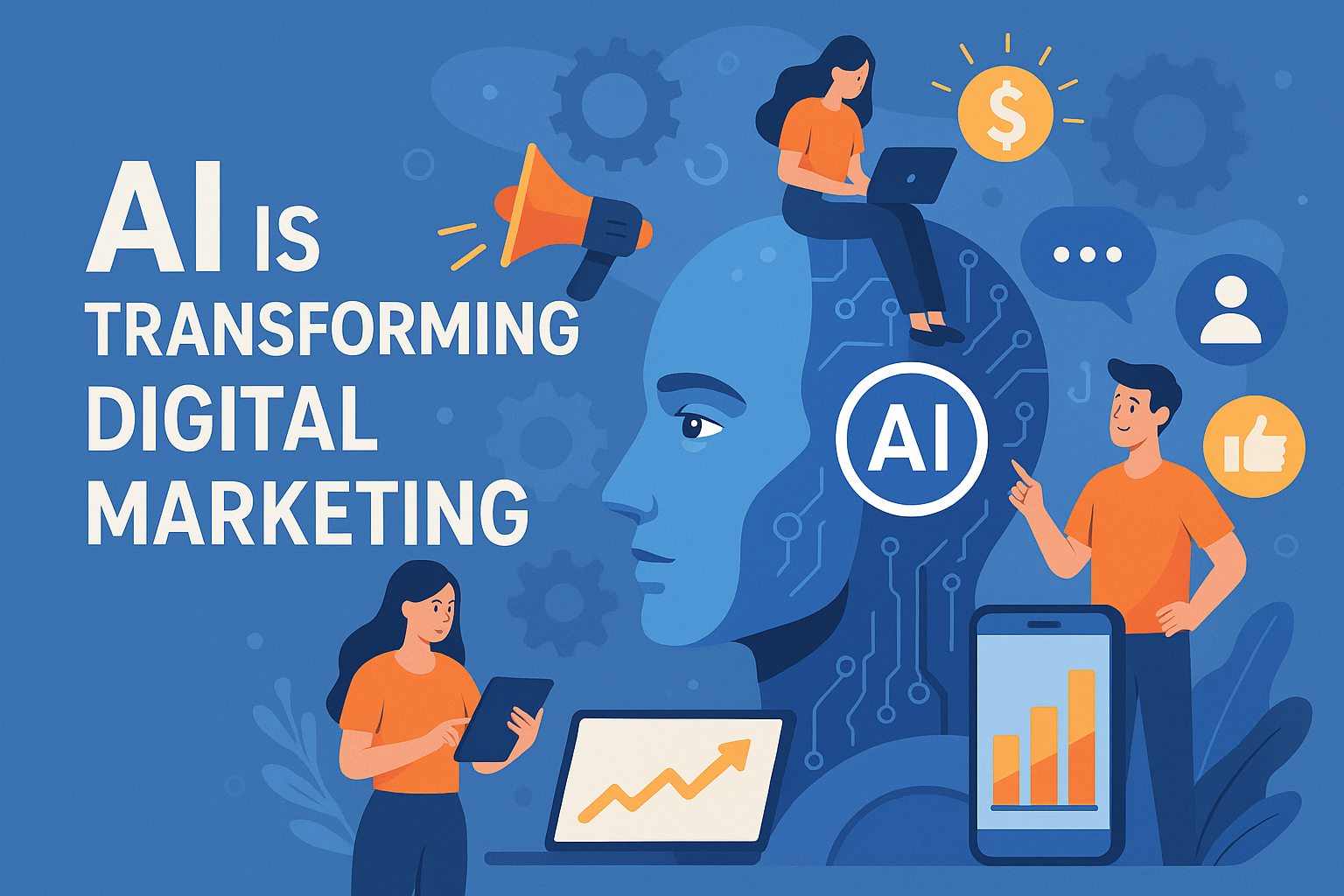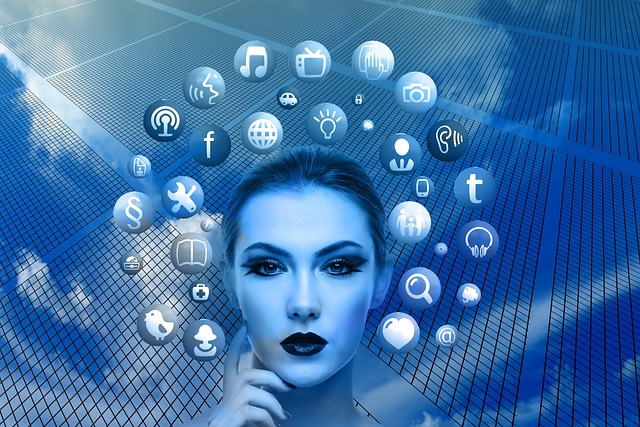Artificial intelligence has moved from an experimental technology to the backbone of digital marketing strategies in 2025. From hyper-personalization to predictive analytics, AI is redefining what's possible in marketing automation, customer engagement, and ROI optimization.
Table of Contents
- 1. The Current State of AI in Digital Marketing
- 2. AI-Powered Hyper-Personalization
- 3. Predictive Analytics and Customer Insights
- 4. AI-Assisted Content Creation
- 5. Advanced Conversational Marketing
- 6. AI-Optimized Advertising Campaigns
- 7. Visual Recognition and Video Analytics
- 8. Enhanced Customer Journey Mapping
- 9. Challenges and Ethical Considerations
- 10. The Future of AI in Marketing
1. The Current State of AI in Digital Marketing
The digital marketing landscape of 2025 is dramatically different from just a few years ago, with AI adoption now widespread across businesses of all sizes. According to the latest Global Marketing Technology Report, 87% of marketers now utilize AI tools in their daily workflows, up from just 29% in 2022.
This rapid adoption has been driven by several factors:
- The maturation and democratization of AI technologies
- Increased competitive pressure to deliver personalized experiences at scale
- Growing consumer expectations for relevant, timely interactions across all touchpoints
- Improved ROI measurement capabilities that clearly demonstrate AI's business impact
Key AI Marketing Statistics for 2025
- 87% of marketers utilize AI tools in their daily workflows
- 73% of enterprises have dedicated AI marketing systems
- Companies using AI for marketing report 34% higher conversion rates
- AI-driven content creation tools reduce production time by 65%
- Customer acquisition costs decrease by 25% with AI-optimized campaigns
2. AI-Powered Hyper-Personalization
Personalization has evolved far beyond simply addressing customers by name. In 2025, AI-driven hyper-personalization analyzes hundreds of data points in real-time to deliver truly individualized experiences across all customer touchpoints.
Modern AI personalization engines incorporate:
- Behavioral Analysis: Real-time monitoring of user interactions across all channels
- Contextual Awareness: Understanding time, location, device, and situational factors
- Emotional Intelligence: Sentiment analysis to gauge customer mood and tailor messaging accordingly
- Predictive Intent: Anticipating customer needs before they're explicitly expressed
Case Study: HealthPlus Pharmacy Network
HealthPlus Pharmacy implemented an AI-powered personalization system that analyzes customer purchase history, prescription data, and health profiles to deliver highly relevant recommendations. Their app now delivers personalized health tips, medication reminders, and product suggestions based on comprehensive customer profiles.
Results:
- 43% increase in repeat purchases
- 27% higher average order value
- 94% customer satisfaction rating
"The key breakthrough in AI personalization isn't just knowing customer preferences, but understanding the context and emotional state behind each interaction. Modern systems can detect subtle signals indicating customer sentiment and adapt messaging accordingly, creating truly resonant experiences."
— Om Prakash Bhardwaj, CEO, Haricane Consultancy
3. Predictive Analytics and Customer Insights
Predictive analytics has evolved from basic forecasting to sophisticated, multi-dimensional modeling that can identify emerging trends and opportunities before they become apparent through traditional analysis.
In 2025, advanced predictive models incorporate:
- Multi-Source Data Fusion: Combining first-party data with third-party insights and market intelligence
- Temporal Pattern Recognition: Identifying cyclical trends and seasonal fluctuations with unprecedented accuracy
- Causal Relationship Mapping: Moving beyond correlation to understand true cause-and-effect relationships
- Anomaly Detection: Spotting unusual patterns that represent either threats or opportunities
// Example of AI-driven Customer Lifetime Value prediction
// Note: This is simplified for illustration
const predictCustomerLTV = async (customerData) => {
// Extract customer features
const features = extractRelevantFeatures(customerData);
// Run features through pre-trained ML model
const predictedSpending = await ltv_model.predict(features);
// Calculate probability of churn
const churnProbability = await churn_model.predict(features);
// Determine optimal engagement strategy
const recommendedActions = await recommendation_engine.getActions({
customerID: customerData.id,
predictedLTV: predictedSpending,
churnRisk: churnProbability,
customerSegment: customerData.segment
});
return {
predictedLTV: predictedSpending,
churnProbability: churnProbability,
recommendedActions: recommendedActions,
confidenceScore: model.getConfidence()
};
};4. AI-Assisted Content Creation
Content creation has been transformed by generative AI technologies that can now produce human-quality text, images, video, and even interactive experiences. In 2025, AI content tools have moved beyond simple generation to become sophisticated co-creation partners that enhance human creativity.
Effective Uses of AI in Content Creation:
- Research Acceleration: Analyzing industry trends and competitor content to identify opportunities
- Content Ideation: Generating unique angles and perspectives based on strategic inputs
- Content Optimization: Enhancing engagement, readability, and SEO factors in real-time
- Cross-Channel Adaptation: Automatically reformatting content for various platforms while maintaining brand voice
- Personalized Content Scaling: Creating variations tailored to different audience segments
Leading brands are implementing sophisticated content workflows that combine AI efficiency with human creativity:
- Strategic briefing and objective setting (human-led)
- Research and data aggregation (AI-assisted)
- Content structure and outline creation (collaborative)
- Initial content generation (AI-driven)
- Creative enhancement and brand alignment (human-led)
- Optimization for engagement and conversion (AI-assisted)
- Performance analysis and iterative improvement (collaborative)
AI Content Creation Best Practices
- Develop clear prompt engineering guidelines to ensure consistent outputs
- Maintain a "human-in-the-loop" approach for quality control and creative direction
- Create content models that reflect your brand voice and style guidelines
- Focus AI on scalable, data-driven tasks while keeping strategic and emotional elements human-led
- Build content frameworks that combine modular AI-generated elements with custom human components
5. Advanced Conversational Marketing
Conversational marketing has evolved from simple chatbots to sophisticated AI assistants that can handle complex queries, recognize emotional signals, and seamlessly transition between automated and human support when necessary.
The latest generation of conversational AI systems feature:
- Contextual Memory: Maintaining conversation history across sessions and channels
- Multimodal Understanding: Processing text, voice, images, and video inputs
- Emotional Intelligence: Detecting and responding appropriately to customer emotions
- Proactive Engagement: Initiating conversations based on behavioral triggers
- Omnichannel Continuity: Maintaining consistent conversations across devices and platforms
Case Study: GlobalTravel Booking Platform
GlobalTravel implemented an advanced conversational AI assistant that helps travelers research destinations, compare options, and book travel arrangements through natural language conversations. The system can understand complex queries like "I want to go somewhere warm with good diving in October for about $2,000 from Chicago" and provide personalized recommendations.
Results:
- 68% of booking inquiries now handled without human intervention
- Average booking time reduced from 27 minutes to 12 minutes
- 37% increase in cross-sell and upsell revenue
- 92% positive customer satisfaction ratings
6. AI-Optimized Advertising Campaigns
Paid advertising has been revolutionized by AI systems that can autonomously optimize campaigns across multiple platforms in real-time. These systems continuously adjust bidding strategies, audience targeting, creative elements, and budget allocation to maximize performance.
The latest AI advertising platforms can:
- Predict Click-Through and Conversion Rates: For each creative variant and audience segment
- Generate and Test Variations: Automatically creating dozens of ad variations to identify winners
- Cross-Platform Optimization: Balancing spend across search, social, display, and video channels
- Competitive Response: Adjusting strategies based on competitor activity
- Budget Forecasting: Predicting optimal spending patterns for maximum ROI
AI Advertising Performance Metrics (Industry Average)
- 30-45% reduction in cost per acquisition
- 50-75% decrease in campaign management time
- 15-25% improvement in conversion rates
- 40-60% increase in ad relevancy scores
- 20-35% higher return on ad spend
7. Visual Recognition and Video Analytics
Visual AI has reached remarkable levels of sophistication in 2025, enabling marketers to analyze and leverage visual content in ways that were previously impossible. Computer vision systems can now understand the context, emotions, and narrative elements within images and videos.
Advanced applications of visual AI in marketing include:
- Visual Listening: Monitoring brand appearances in user-generated content across platforms
- Engagement Analytics: Measuring viewer attention and emotional response to video content
- Visual Personalization: Customizing images and videos based on viewer preferences
- Augmented Reality Integration: Creating interactive visual experiences customized to individual users
- Automated Video Optimization: Identifying the most engaging segments for different audience segments
8. Enhanced Customer Journey Mapping
AI-powered customer journey mapping has evolved from static, assumption-based models to dynamic systems that continuously analyze actual customer behavior across all touchpoints. These platforms can identify patterns, friction points, and opportunities that would be impossible to discover through traditional analysis.
Modern AI journey mapping capabilities include:
- Multi-Channel Path Analysis: Tracking customer movement across online and offline touchpoints
- Micro-Moment Identification: Pinpointing critical decision points in the customer journey
- Sentiment Tracking: Monitoring emotional responses throughout the journey
- Predictive Next-Best-Action: Recommending optimal interventions at each stage
- Conversion Funnel Optimization: Automatically identifying and addressing drop-off points
"The most significant advancement in AI customer journey mapping isn't just the ability to track behavior, but to understand the 'why' behind it. Modern systems detect frustration signals, moments of delight, and decision patterns that reveal the true customer experience beyond the raw metrics."
— Om Prakash Bhardwaj, CEO, Haricane Consultancy
9. Challenges and Ethical Considerations
Despite the tremendous benefits of AI in marketing, significant challenges and ethical considerations require careful attention as these technologies become more deeply embedded in marketing operations.
Key Challenges and Mitigation Strategies:
- Data Privacy Concerns:
- Implement privacy-by-design principles in all AI systems
- Use federated learning to analyze data without centralizing sensitive information
- Provide clear, granular consent options for data usage
- Algorithmic Bias:
- Regularly audit AI systems for potential biases in decision-making
- Use diverse training data sets to minimize representation issues
- Implement bias detection tools in your model monitoring
- Transparency and Explainability:
- Use explainable AI models when making consequential decisions
- Provide clear disclosure when customers are interacting with AI systems
- Document decision logic in customer-facing AI applications
- Over-Automation:
- Maintain human oversight for sensitive customer interactions
- Design systems with appropriate human intervention points
- Balance automation with authentic human connection
10. The Future of AI in Marketing
As we look beyond 2025, several emerging trends are poised to further transform the AI marketing landscape:
- Multimodal AI Integration: Systems that seamlessly process and generate text, voice, image, and video simultaneously
- Zero-Party Data Optimization: AI that maximizes insights from explicitly shared customer preferences while reducing dependence on tracking
- Emotional Targeting Evolution: More sophisticated systems that understand and respond to complex human emotions
- Quantum-Enhanced Algorithms: Marketing optimization that leverages quantum computing for previously impossible analytical tasks
- Augmented Creativity: AI systems that function as true creative partners rather than just production tools
Embracing the AI Marketing Revolution
The transformation of digital marketing through AI is not just about technology adoption but represents a fundamental shift in how brands connect with customers. Organizations that develop strategic approaches to AI integration—balancing automation with humanity, efficiency with creativity, and personalization with privacy—will gain sustainable competitive advantages in the coming years.
The most successful marketers of 2025 and beyond will be those who view AI not as a replacement for human creativity and strategic thinking, but as a powerful amplifier that enables more meaningful, relevant, and effective customer experiences at scale.
Ready to Transform Your Marketing with AI?
Our team of AI marketing specialists at Haricane Consultancy Services can help you develop and implement a strategic approach to AI adoption that aligns with your business objectives and delivers measurable results.
Schedule a Free Consultation



Comments (2)
Manish Raj
March 29, 2025This article provides an excellent overview of how AI is reshaping digital marketing. I particularly appreciated the case studies and concrete examples. As a marketing director for a mid-sized e-commerce company, I'm curious about implementation costs. What would be a realistic budget for a company looking to start with AI-powered personalization?
Om Prakash Bhardwaj
Author March 30, 2025Hi Manish, great question! Implementation costs vary widely based on your existing tech stack and specific needs. For mid-sized e-commerce businesses, I typically recommend starting with a phased approach. Many platforms now offer AI personalization modules with entry points around ₹1,00,000-3,00,000 per month. You can begin with product recommendations and email personalization, then expand to more advanced applications as you see ROI. Many of our clients achieve positive returns within 3-4 months. I'd be happy to discuss your specific situation in more detail if you'd like to reach out directly.
Leave a Comment